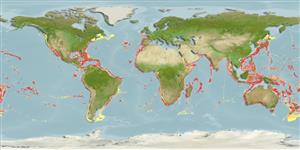>
Scombriformes (Mackerels) >
Gempylidae (Snake mackerels)
Etymology: Lepidocybium: Greek, lepis = scale + Greek, kybion, -ou = tunna (Ref. 45335).
Environment: milieu / climate zone / Mức độ sâu / distribution range
Sinh thái học
Biển Sống nổi và đáy; Ở đại duơng, biển (Ref. 51243); Mức độ sâu 200 - 1100 m (Ref. 44037). Deep-water; 50°N - 56°S, 180°W - 180°E (Ref. 6181)
Tropical and temperate seas of the World, but probably not occurring in the northern Indian Ocean. Northwest Atlantic: Canada (Ref. 5951). Eastern Atlantic: known from 13°N off Guinea to Lobutu, Angola (Ref. 10816).
Bộ gần gũi / Khối lượng (Trọng lượng) / Age
Chín muồi sinh dục: Lm ? range ? - ? cm
Max length : 200 cm SL con đực/không giới tính; (Ref. 6181); common length : 150 cm SL con đực/không giới tính; (Ref. 6181); Khối lượng cực đại được công bố: 45.0 kg (Ref. 3403)
Các tia vây lưng cứng (tổng cộng) : 8 - 9; Các vây lưng mềm (tổng cộng) : 16 - 18; Tia cứng vây hậu môn: 1 - 2; Tia mềm vây hậu môn: 12 - 14; Động vật có xương sống: 31. Body almost uniformly dark brown, becoming almost black with age. Pelvic fins well developed, with I spine and 5 soft rays (Ref. 9784). Prominent lateral keel on caudal peduncle, flanked by smaller accessory keels above and below (Ref. 26938).
Body shape (shape guide): fusiform / normal; Cross section: oval.
Occurs mainly over the continental slope, down to 200 m and more (Ref. 6181). Migrates upward at night (Ref. 6181). Feeds on squid, crustaceans and a wide variety of fishes (Ref. 6181). Flesh oily and may have purgative properties (Ref. 9784). Sometimes caught by tuna long-liners (Ref. 26938). Marketed frozen and as fish cakes in Japan (Ref. 9302).
Life cycle and mating behavior
Chín muồi sinh dục | Sự tái sinh sản | Đẻ trứng | Các trứng | Sự sinh sản | Ấu trùng
Nakamura, I. and N.V. Parin, 1993. FAO Species Catalogue. Vol. 15. Snake mackerels and cutlassfishes of the world (families Gempylidae and Trichiuridae). An annotated and illustrated catalogue of the snake mackerels, snoeks, escolars, gemfishes, sackfishes, domine, oilfish, cutlassfishes,. scabbardfishes, hairtails, and frostfishes known to date. FAO Fish. Synop. 125(15):136 p. (Ref. 6181)
IUCN Red List Status (Ref. 130435: Version 2024-2)
Threat to humans
Harmless
Human uses
Các nghề cá: buôn bán nhỏ; cá để chơi: đúng
Các công cụ
Special reports
Download XML
Các nguồn internet
Estimates based on models
Preferred temperature (Tài liệu tham khảo
123201): 7 - 14.4, mean 9.9 °C (based on 642 cells).
Phylogenetic diversity index (Tài liệu tham khảo
82804): PD
50 = 1.0000 [Uniqueness, from 0.5 = low to 2.0 = high].
Bayesian length-weight: a=0.01202 (0.00608 - 0.02377), b=2.98 (2.80 - 3.16), in cm total length, based on LWR estimates for this species & (Sub)family-body (Ref.
93245).
Mức dinh dưỡng (Tài liệu tham khảo
69278): 4.3 ±0.67 se; based on food items.
Thích nghi nhanh (Tài liệu tham khảo
120179): thấp, thời gian nhân đôi của chủng quần tối thiểu là 4.5 - 14 năm (Assuming tm=4-5).
Fishing Vulnerability (Ref.
59153): Very high vulnerability (90 of 100).
🛈
Climate Vulnerability (Ref.
125649): Moderate vulnerability (39 of 100).
🛈
Nutrients (Ref.
124155): Calcium = 7.33 [3.81, 15.92] mg/100g; Iron = 0.279 [0.128, 0.578] mg/100g; Protein = 17.1 [14.9, 19.0] %; Omega3 = 0.33 [0.19, 0.60] g/100g; Selenium = 29.2 [12.6, 64.6] μg/100g; VitaminA = 11.8 [2.8, 50.1] μg/100g; Zinc = 0.25 [0.17, 0.37] mg/100g (wet weight);
